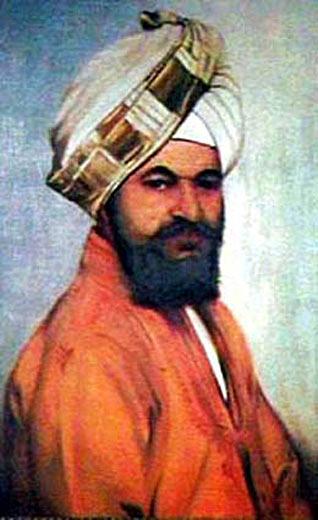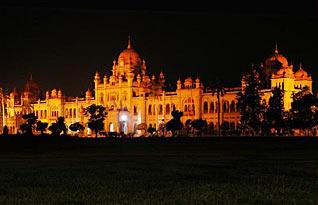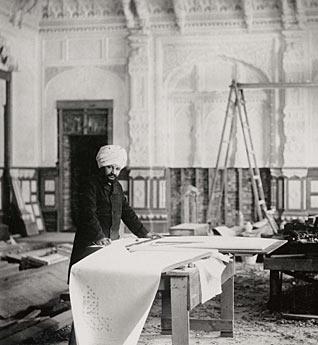Architecture
BHAI RAM SINGH
The Grand Architect
A Book Review by DR AMRIK SINGH
THE RAJ, LAHORE AND BHAI RAM SINGH, by Pervez and Sajida Vandal. National College of Arts, Lahore. Pages: 268. Rs 1,500
Ask anyone in Punjab about Bhai Ram Singh and you would invite blank stares, even in Amritsar, where there should be good reason to remember him. He was the man who designed Khalsa College (now the home of Guru Nanak University), Amritsar, in 1892. Even the persons connected with the college (I was a student there for four years and a teacher for six years) hardly know anything about him. There was little I could say about Bhai Ram Singh until I had read this book.
He was one of the outstanding Indians in the late 19th century, much sought after he designed buildings in the princely states of Jind, Nabha, Patiala, Bhawalpore, Jammu and Kashmir, Mysore and so on. For more than two decades, he dominated the architectural scene without a rival.
In Lahore, he designed the Chiefs College, Lahore Museum, the Mayo School of Arts, Punjab University Senate House and scores of other buildings, including the Governor's House in Simla. At Lyallpur, he designed the College of Agriculture. He was the chief designer of buildings in Punjab in those years, and the man who built them was Sir Ganga Ram. Between the two of them, they shaped pre-1947 Lahore.
Apart from the walled city and some Mughal buildings that existed earlier, the rest of the city was built in terms of what he designed.
Those concerned with city planning and architecture know that Sir Ganga Ram had a memorable role in the making of Lahore. He was popular in any case, as apart from being a remarkable builder, he was also a philanthropist. The medical college and hospital, founded in his name a couple of years before Partition, still run under his name. A good deal has been written about him, but it took only this author couple to rediscover Bhai Ram Singh.
Like any architect in the subcontinent, the issue before them was to look for appropriate architecture for this region. Apart from the Mughal heritage, the colonial heritage was also a factor in his mind. Since 90 per cent of the Lahore architecture is colonial, those concerned with this issue focused on Sir Ganga Ram and Bhai Ram Singh.
In this first book that brings out the rich and varied contribution of Bhai Ram Singh, there are chapters dealing with the right kind of architecture for the Raj, the transformation of Lahore, the growth of native architecture and the changes. Half of this lavishly produced and illustrated book is devoted to these issues and the other half deals with the personal life and professional career of Bhai Ram Singh.
He was born in a family of carpenters in a village near Batala and had a good sense of design and understanding of things mechanical. He was not even 14 when he repaired the piano of the Deputy Commissioner of Amritsar, even though he had no training of any kind.
When the Mayo School of Arts was established in 1875, he got admission there and learnt English, basic drawing, mathematics, geometry, indeed everything connected with his profession. He integrated the colonial with the native tradition in furniture making, tapestry making, interior decoration and architecture. Working under the guidance of his Principal, Kipling, he soon surpassed his peers.
The Great Exhibition of 1851 in London had generated two streams of influence. One was reform in art education and the second was trade in oriental wares. Both had their impact on India. The establishment of the Mayo School of Arts was a case in point.
After 8 years of studentship, he became assistant drawing master in Mayo School. In the early 1880's, Principal Kipling (whose son, Rudyard, went on to win the Noble Prize) took him to Calcutta for an exhibition and introduced him to the Duke and Duchess of Connaught, who admired his work and invited him to the UK a little later. He performed so well there that Queen Victoria asked him to design an Indian Room in one of her palaces.
After two years in England, by the time he returned, he was so famous that achievement, honours and popularity were almost instant. Though delayed by several years, he ultimately became the Principal of the Mayo School of Arts, even though he had hardly any "formal education". What he achieved was based on his profound knowledge of the native tradition and the quality of his work.
His family is still here, but most of the material relating to him is to be found in Lahore. Perhaps Khalsa College, Amritsar, may like to enter some kind of an arrangement with the authors to reproduce the portion dealing with Bhai Ram Singh in the book in India or get a new book written. His portrait hangs in one of the Queen's palaces in England, but nowhere in India.
It wouldn't be bad even to name some college of art or architecture after him.
[Dr Amrik Singh is the former Vice-Chancellor of Punjabi University, Patiala, and the former Chair of the University Grants Commission, India.]
Courtesy: The Tribune.
Images of Bhai Ram Singh: Courtesy - Anglo-Sikh Heritage Trail
Conversation about this article
1: Kuldip Singh (Canada), July 01, 2009, 10:50 AM.
I was privileged to receive a copy of the book THE RAJ, LAHORE AND BHAI RAM SINGH, by Pervez and Sajida Vandal. The book is an excellent collection of art work done by my great-great grandfather Sardar Bahadar Ram Singh. No one in Punjab, India or elsewhere has given him and his life-work due recognition; not even in his home town, Amritsar.
2: Ann (U.K.), July 19, 2009, 10:24 AM.
I have an interesting story to share with you. Several years ago, I purchased a pastel portrait of a Sikh in Northern Ireland. Although it was signed, I have never been able to contact the artist to identify the subject. On a trip to the Isle of Wight on a visit to Osborne House, I discovered that it was Bhai Ram Singh. The portrait I have is larger than the original but of excellent quality, bearing only two differences from the original. I feel very privileged to own it as to my knowledge it is the only other one in existence. I have contacted the curator at Osborne who may visit to inspect my copy next time he is in my area. I thought you would like to know.
3: Muhammad Adeel Qureshi (Pakistan), October 27, 2009, 5:01 AM.
As a lecturer in Architecture, I found this book a wonderful source for the Royal Lahore.
4: Ajit Singh (Norwalk, CT U.S.A.), January 23, 2010, 10:17 PM.
My father always talked about his uncle Sardar Ram Singh, the great architect. I could never trace his offsprings. I am so excited to discover his great great grand son Kuldip Singh in Canada. I would be very thankful if I can get in touch with him, or find out about his whereabouts, his phone, e-mail address, etc.
5: Daniyal (Ireland), June 12, 2010, 12:07 PM.
We all Lahorites are thankful to Bhai Ram Singh and Sir Ganga Ram for making Lahore. I was fortunate to live and grow up in one of the flats in Ganga Ram Mansion on Mall Road, Lahore, which were designed and made by these great men.
6: Zubair (Islamabad, Pakistan), October 07, 2010, 3:08 PM.
The white marble canopy in front of the Punjab Assembly Building that once housed the statue of Queen Victoria was designed by Bhai Ram Singh. I cannot find any reference to the effect. Can anyone confirm or contradict this fact?
7: Shiraz Hassan (Lahore, Punjab, Pakistan), April 27, 2011, 9:08 AM.
Lahore is thankful to Bhai Ram Singh. We salute him.
8: Jatinder Singh Chadha (Delhi, India), June 05, 2012, 4:41 PM.
I am Jatinder Singh Chadha, great grandson of Bhai Ram Singh. Heard about his achievements from various sources and family members as well. Would really appreciate it if descendants of Bhai Ram Singh could get in touch with me through this site and share more of his glorious achievements.
9: Prabhjot Kaur (Pathankot, Punjab), December 18, 2012, 7:12 AM.
I am great grand daughter of Bhai Ram Singh. I would like to know about, or hear from, his other descendants.
10: Jatinder Singh Chadha (Delhi, India), June 25, 2013, 4:02 PM.
I am Jatinder Singh Chadha, great-grandson of Bhai Ram Singh. Proud of his achievements. Would like to get in touch with his other descendants.
11: Pauly Pops (United Kingdom), May 22, 2014, 1:03 PM.
I'm trying to buy a copy of this book but cannot find it anywhere. Any ideas? [EDITOR: Have you tried online?]
12: Sital Singh Sohal (Cupertino, California, USA), November 14, 2014, 1:17 PM.
I am grandson of Sardar Bahadur Ram Singh ji. My father S. Sulakhan Singh was a Civil Engineer in Glasgow, Scotland, and a Chartered Civil from London, A.M.I.C.E (Lond). I have two brothers living in London at Heathrow: Sant Singh and Beant Singh. I am disappointed that my grandfather S. Ram Singh is not mentioned in the BBC list of prominent Sikhs from history.
13: Mamta Matharu (Delhi, India), August 29, 2015, 4:17 AM.
I have an original photograph of Sardar Ram Singh, the same that features with his medals sitting on a chair in my grandfather's album (Late Sardar Harnam Singh), who I believe was closely related to him. My grandfather also belonged to Amritsar and during the British era worked in Bengal and held an eminent position. I would appreciate more information, based on this account, if anyone can help.
14: Hardeep Singh Dhanjal (India), February 10, 2017, 12:13 PM.
My name is Hardeep Singh Dhanjal. My Grandmother (Gurbachan Kaur) was the daughter of Sardar Bahadar Ram Singh ji. I still have some belongings of Sardar Bahadar Ram Singh ji.
15: Sangeet Sharma (Chandigarh, Punjab), June 27, 2018, 1:27 PM.
I am an architect in Chandigarh, Punjab. I am writing a book on Bhai Ram Singh. I am penning his life through fiction. Being an architect, I can empathize closely with his challenges and achievements. Please help me all to provide data, facts, dates, his wife’s name and biography, etc. I will be visiting Osborne house in September. Is there any record of the “drawings“ in any library?





